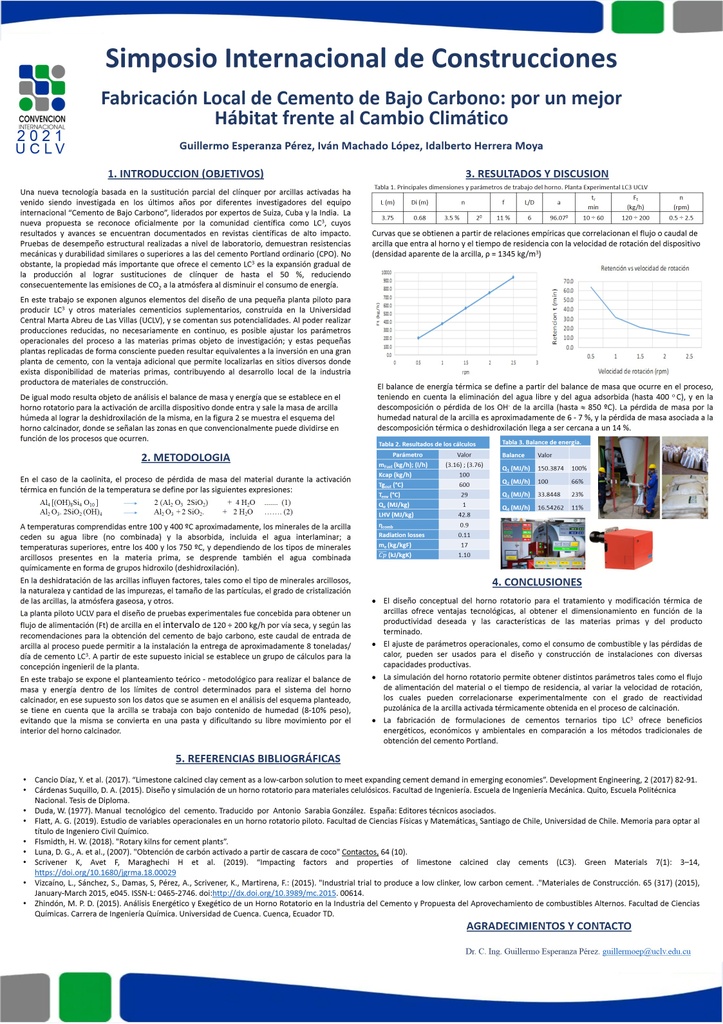Executive Secretary

Simposio Internacional de Construcciones

The sustained confrontation that takes place on a global scale, with increasing frequency, against the adverse and catastrophic effects of extreme meteorological events generated as a consequence of climate change, which arrive without prior warning, is well known. Linked to this, the world industrial production of Portland Cement, basic building material par excellence, contributes with about 8% of global CO2 emissions. The incessant search for alternative solutions, such as new formulations of ternary binders, or low carbon cements (LC3), is in the sights of various scientific institutions, and can be an important way to contribute to the achievement of a gradual reduction of these emissions. This work shows the Cuban experiences in the assembly, start-up and operation of an experimental pilot installation for the production of LC3 at the Central University “Marta Abreu” of Las Villas, some characteristics of low-carbon cement are described, they are exposed the necessary calculations for the preliminary mechanical design of the rotary calciner kiln, considered the main equipment of the plant, as well as the calculation of the balance of materials and energy, and the sources of its low environmental impact, clarifying the significant reduction achieved in terms of emissions. Finally, the experiences of the application of these cementitious materials in the local manufacture of construction materials are reflected, reaching in the tested mixtures compressive strength values that ranged between 37.5 and 40 MPa for 28 days of aging.
Es bien conocido el enfrentamiento sostenido que se realiza a escala global, cada vez con mayor frecuencia, contra los efectos adversos y catastróficos de eventos meteorológicos extremos generados como consecuencia del cambio climático, los cuales llegan sin previo aviso. Vinculado a ello, la producción industrial mundial de cemento Portland, material de construcción básico por excelencia, contribuye con cerca de un 8 % de las emisiones globales de CO2. La búsqueda incesante de soluciones alternativas, como las nuevas formulaciones de aglomerantes ternarios, o cementos de bajo carbono (LC3), está en la mira de diversas instituciones científicas, y puede ser una vía importante para contribuir al logro de una reducción gradual de esas emisiones.
En el presente trabajo se muestran las experiencias cubanas en el montaje, puesta en marcha y operación de una instalación piloto experimental para la producción de LC3 en la Universidad Central Marta Abreu de Las Villas, se describen algunas características del cemento de bajo carbono, se exponen los cálculos necesarios para el diseño mecánico preliminar del horno calcinador rotatorio, considerado el equipo principal de la planta, así como el cálculo de los balances de materiales y energía, y las fuentes de su bajo impacto ambiental, esclareciendo la importante reducción lograda en cuanto a emisiones. Finalmente se reflejan las experiencias de la aplicación de estos materiales cementicios en la fabricación local de materiales de construcción, alcanzándose en las mezclas ensayadas valores de resistencia a la compresión que oscilaron entre 37.5 y 40 MPa para 28 días de envejecimiento.
About The Speaker

Ing Guillermo Esperanza Pérez
